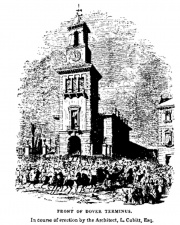South Eastern Railway





of London Bridge Railway Station, London.
The South Eastern Railway (SER) was a railway company in the United Kingdom, which linked London with Kent.
General
The first railway built in the South of England was the Canterbury and Whitstable Railway, which was sanctioned in 1825 - it was opened on May 3rd, 1830. It ran from Whitstable Harbour to Slade-lane, Canterbury. The Act provided that it was to be worked by locomotives, fixed engines and horses. There were three winding engines and some of the gradients were 1 in 28, 1 in 31 and 1 in 46. There was one tunnel - Tyler Hill - 828 yards long. The locomotive used was the well-known Invicta, built by Stephenson immediately after the Rocket.[1]. This became part of the South Eastern Railway.
The next oldest was the London and Greenwich Railway - sanctioned in 1833 - which was the first railway in the Metropolis. It began in Duke-street near London Bridge, and ended in London-street, Greenwich; it had an intermediate station at Spa-road. The line was on arches throughout, with the idea that road traffic would not be interfered with, and that the arches would bring in a revenue from rents as warehouses, shops and dwelling places. There were 880 arches. The line was opened from London to Deptford on December 14th, 1836, but some portion must have been opened earlier than that as the line was in use on the Easter Monday 1836. The portion from Deptford to Greenwich was brought into use on December 24th, 1838. [2]
1836 The South Eastern Railway company was incorporated. The company was formed from the London and Greenwich Railway (LGR) and the Canterbury and Whitstable Railway (CWR). At Bermondsey there was a junction for the London and Croydon Railway, opened in 1839.
The South Eastern had powers to make a railway from the London and Croydon Railway to Dover. The line did not, however, materialise as such. Its promoters were anxious to serve Brighton as well as Dover and, by agreement with the London and Brighton Railway, a clause was inserted in the latter company's Act allowing the South-Eastern, any time before December 1st, 1840, to purchase the Brighton line from London up to the point where the Dover line diverged towards Kent. [3]
By 1839 this arrangement was changed; the South Eastern proper was to start at Reigate-Redhill, and northwards of that point the Brighton line was to be jointly owned by both companies; from Norwood to Coulsdon the line was vested in the Brighton Company, and from Coulsdon to Redhill in the South-Eastern. The latter company paid £340,000 for this privilege, and its trains ran free of toll. The Brighton was also to run toll free between Croydon and Redhill and over the Greenwich line and the Bricklayer's Arms branch. There was also to be a joint station at London Bridge. Cubitt was the engineer. [4]
1841 The line opened to Redhill
1842 Joint Committee was established to manage the rolling stock of the Croydon and Dover lines in common. Benjamin Cubitt was the first Locomotive Superintendent and controlled the Joint Committee [5].
1844 The Brighton company's engines were brought into the common stock.
1844 The company opened its first station in Dover, in the Pier area of the town. The company developed plans for an ornate Italianate station but this was never built[6]
1845 Control of the London and Greenwich Railway passed to the South Eastern Railway which leased the line (3.75 miles in length) for 999 years.
1846 The Joint Committee was abolished; the Croydon stock was divided between the Brighton and Dover (South Eastern) companies.
1849 The South Eastern Railway and the London, Brighton and South Coast Railway agreed on access to London, something which had been a source of friction between the companies. The SER obtained access over the "Croydon" lines to Corbett's Lane junction with the London and Greenwich Railway.
1851 The North Kent Line to Strood was opened.
The SER decided not to connect the new East Kent Railway with its North Kent Line so the East Kent built its own line connecting Rochester and Canterbury, building its own station at Canterbury.
1859 The East Kent changed its name to London, Chatham and Dover Railway.
1859 An independent company, the London Bridge and Charing Cross Railway was incorporated with support from the SER, as it would help give the company access to the West End of London.
1861 After the LCDR opened its line to Dover (Harbour), the SER changed the name of its station in Dover to Dover Town.
1864 The line into Charing Cross, over Hungerford Bridge, was opened.
1866 Opened the new Cannon Street Railway Station on the north side of the river
1869 A station at Waterloo Junction, adjacent to the LSWR Waterloo station, opened.
1875 See 1875 Number of Locomotives
1882 William Wainwright was appointed Chief Carriage and Wagon Superintendent
1888 See Locomotive Stock June 1888
1895 Harry Smith Wainwright was appointed Carriage and wagon superintendent.
1898 As a result of negotiations, an agreement was made with the London, Chatham and Dover Railway company for an improved, efficient and economical working of the competitive traffic, this agreement taking effect from January 1st 1899 [7]. The combined operation was known as the South Eastern and Chatham Railways.
Chief Engineers
- Benjamin Cubitt: 1842-1845
- James I'Anson Cudworth: 1845-1876
- A. M. Watkin: 1876-1877
- R. Mansell: 1877-1878
- James Stirling: 1878-1898











